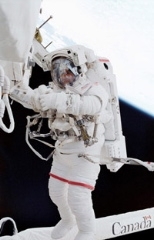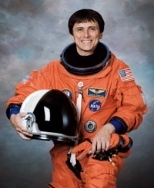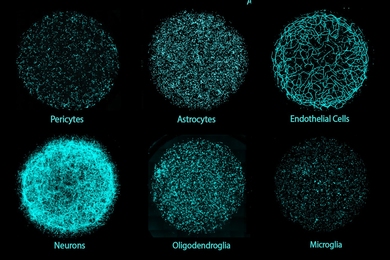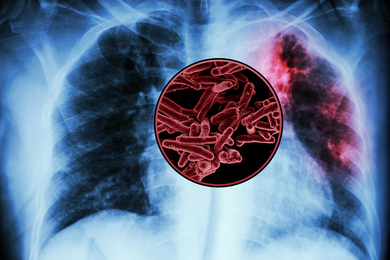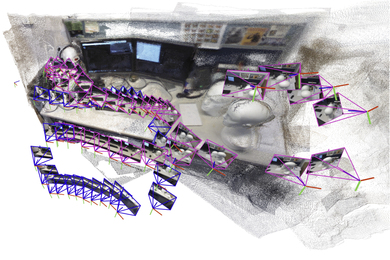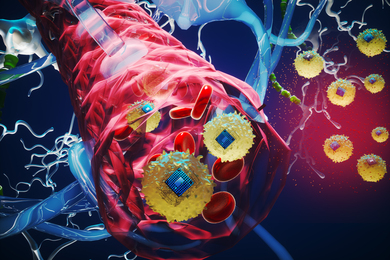It took seven shuttle missions over two decades, but astronaut Franklin Chang-Diaz (Sc.D. 1977) finally realized his dream of walking in space during last month's STS-111 mission on the space shuttle Endeavour.
"It was a beautiful experience, especially the first EVA [space walk], when I was riding on the arm and got to see a huge panorama of the world. It was an overcoming experience. I could hardly contain the emotions," Chang-Diaz said.
"I had seen the Earth so many times through the shuttle's flat, three-pane window. But when you look at it through the helmet visor you have no glare ... it's just so crisp, like you've just increased the resolution," he said. "There was a beautiful aurora in the southern hemisphere. This one was panoramic and completely clear. I had a lot of time to ponder and take it all in. It was just an awesome experience.
"At night, the sky is just absolutely breathtaking. You forget you're hanging off the arm ... you're floating in the void of space. You see stars everywhere above the faint view of the Earth in darkness," Chang-Diaz said.
When asked if the experience was worth waiting 20 years for, he said, "Absolutely, every minute of it. We still wake up with smiles on our faces even though we're tired."
Along with French astronaut Philippe Perrin, Chang-Diaz trained to perform two space walks outside the shuttle (extravehicular activities, or EVAs) to assemble components of the International Space Station. In late March, when the space station's robot arm was continuing to have hardware problems, a decision was made to add a third EVA to replace the arm's wrist-roll joint.
Successful completion of this complex task was viewed as critical to the long-term space station assembly effort, which relies extensively on the Canadian-built robot arm. All three EVAs, including the on-orbit robotic arm surgery, were conducted flawlessly.
"I know personally how much this means to him ... I'm delighted that after all this time he finally got a chance to go outside the spacecraft," said fellow astronaut Jeffrey Hoffman, who trained with Chang-Diaz for a contingency EVA on STS-46 in July 1992. Hoffman is now a senior lecturer in MIT's Department of Aeronautics and Astronautics.
Chang-Diaz also served as flight engineer on the recent mission, assisting the commander and pilot in critical mission phases like ascent and entry. "Franklin is well respected for his consummate abilities and knowledge of the space shuttle and its systems. So he's the perfect guy to have as flight engineer," said mission commander Ken Cockrell.
RECORD-TYING FLIGHT
Chang-Diaz completed his record-tying seventh space flight with the successful return of Endeavour on June 19. Only one other astronaut, Jerry Ross, has flown in space seven times.
"Being an astronaut has been a dream of my life, ever since I was very little," Chang-Diaz said. "I tried to make that dream come true and I'm hoping that perhaps this is in the minds of many other children as we open up space for human exploration--that many children all over the world will have the opportunity to dream about it and someday realize those dreams."
Since his selection as a NASA astronaut in 1981, Chang-Diaz has served as a mission specialist on some of the most interesting space missions over the last two decades. On his first mission, STS-61C in 1986, Chang-Diaz helped deploy a commercial communications satellite and conducted experiments in astrophysics. On the STS-34 mission in 1989, he helped launch the Galileo spacecraft on its voyage to explore Jupiter and its moons. Galileo is still sending back valuable scientific data on Jupiter and its environment.
On STS-60 in 1994, Chang-Diaz served with the first Russian cosmonaut to fly on a U.S.-launched space mission. Two of his missions, STS-46 in 1992 and STS-75 in 1996, involved experiments that successfully demonstrated the generation of electricity from tethered satellite systems.
And on STS-91 in 1998, he visited the Mir space station and helped operate the Alpha Magnetic Spectrometer experiment designed to search for antimatter in space. That experiment was developed by Nobel laureate Samuel Ting, the Thomas Dudley Cabot Professor of Physics and researcher at MIT's Laboratory for Nuclear Science.
A native of Costa Rica, Chang-Diaz received his doctorate in applied plasma physics from MIT in 1977. Despite his busy training schedule, he still conducts research in rocket propulsion based on magnetically confined high-temperature plasmas. He now serves as director of the Advanced Space Propulsion Laboratory at the Johnson Space Center in Houston. Chang-Diaz was a visiting scientist at the Plasma Fusion Center from 1983-93.
A version of this article appeared in MIT Tech Talk on July 17, 2002.
